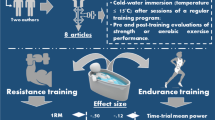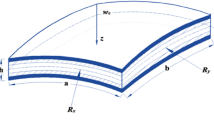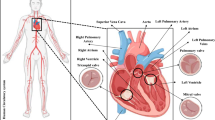Abstract
It is known that atherosclerosis disease can lead to narrowing of human arteries over time. In this research, the flow field in the left external carotid artery is studied numerically considering fluid–structure interactions and effect of different activities on the risk of atherosclerosis disease is evaluated. In this research, it is studied as to whether having physical exercise can reduce the risk of this disease to a great extent. The artery’s tissue is assumed homogeneous and isotropic hyperelastic in fluid–structure interaction simulations. The normal heart cycle (without physical activity) is considered 0.8 s (75 bpm), and the effects of normal and high activities (having physical exercise with heart rates of 100, 120 and 150 bpm) are studied on the artery’s parameters (one healthy subject is studied). It is shown that the results obtained by considering fluid–structure interaction are close to those of rigid wall consideration in low activity. However, when the person has very high activity (i.e., heart rates of 120 and 150 bpm), the differences become noticeable, and rigid wall assumption cannot be correct. Wall shear stress is one of the parameters that shows specific reaction to high exercise. Maximum difference between time average wall shear stress in normal activity and very high activity (150 bpm) is about 103.7% for FSI simulation. Wall shear stress also shows greater difference between fluid–structure interaction and rigid wall consideration with respect to the other parameters by 36.2% in very high activity.

























Similar content being viewed by others
References
Benetos A, Laurent S, Hoeks AP, Boutouyrie PH, Safar ME (1993) Arterial alterations with aging and high blood pressure. A noninvasive study of carotid and femoral arteries. Arterioscler Thromb Vasc Biol 13(1):90–97
Binu L, Kumar AS (2012) Simulation of left main coronary bifurcation lesions using 3D computational fluid dynamics model and its comparison with 2D. In: Proceedings of the world congress on engineering, London, UK
Chung S, Vafai K (2012) Effect of the fluid–structure interactions on low-density lipoprotein transport within a multi-layered arterial wall. J Biomech 45(2):371–381
Craven TE, Ryu JE, Espeland MA, Kahl FR, McKinney WM, Toole JF, McMahan MR, Thompson CJ, Heiss G, Crouse JR (1990) Evaluation of the associations between carotid artery atherosclerosis and coronary artery stenosis. A case-control study. Circulation. 82(4):1230–1242
De Wilde D, Trachet B, De Meyer G, Segers P (2016) The influence of anesthesia and fluid–structure interaction on simulated shear stress patterns in the carotid bifurcation of mice. J Biomech 49(13):2741–2747
Garcia LA (2006) Epidemiology and pathophysiology of lower extremity peripheral arterial disease. J Endovasc Ther 13(2 suppl):II-3–II-9
Giannattasio C, Salvi P, Valbusa F, Kearney-Schwartz A, Capra A, Amigoni M et al (2008) Simultaneous measurement of beat-to-beat carotid diameter and pressure changes to assess arterial mechanical properties. Hypertension 52(5):896–902
Glasser SP, Arnett DK, McVeigh GE, Finkelstein SM, Bank AK, Morgan DJ, Cohn JN (1998) The importance of arterial compliance in cardiovascular drug therapy. J Clin Pharmacol 38(3):202–212
Kim CS, Kim HJ, Won YJ, Kim DJ, Kang ES, Ahn CW et al (2006) Normative values of carotid artery intima-media thickness in healthy Korean adults and estimation of macrovascular diseases relative risk using this data in type 2 diabetes patients. Diabetes Res Clin Pract 72(2):183–189
Kock SA, Nygaard JV, Eldrup N, Fründ ET, Klærke A, Paaske WP, Falk E, Kim WY (2008) Mechanical stresses in carotid plaques using MRI-based fluid–structure interaction models. J Biomech 41(8):1651–1658
Kouhia R (2004) Computational techniques for the non-linear analysis of structures. Lecture note, Tampere University of Technology, Department of Mechanics and Design, Finland
Marshall I, Zhao S, Papathanasopoulou P, Hoskins P, Xu XY (2004) MRI and CFD studies of pulsatile flow in healthy and stenosed carotid bifurcation models. J Biomech 37(5):679–687
Maurits N, Loots G, Veldman A (2007) The influence of vessel wall elasticity and peripheral resistance on the carotid artery flow wave form: a CFD model compared to in vivo ultrasound measurements. J Biomech 40(2):427–436
McVeigh GE, Bank AJ, Cohn JN (2007) Arterial compliance. Cardiovascular medicine. Springer, London, pp 1811–1831
Miyai N, Arita M, Miyashita K, Morioka I, Shiraishi T, Nishio I (2002) Blood pressure response to heart rate during exercise test and risk of future hypertension. Hypertension 39(3):761–766
Moll R, Dinkel H (2001) Value of the CT angiography in the diagnosis of common carotid artery bifurcation disease: CT angiography versus digital subtraction angiography and color flow Doppler. Eur J Radiol 39(3):155–162
Piskin S, Celebi MS (2013) Analysis of the effects of different pulsatile inlet profiles on the hemodynamical properties of blood flow in patient specific carotid artery with stenosis. Comput Biol Med 43(6):717–728
Reid DB, Irshad K, Miller S, Reid AW, Reid W, Diethrich EB (2004) Endovascular significance of the external carotid artery in the treatment of cerebrovascular insufficiency. J Endovasc Ther 11(6):727–733
Reneman RS, Van Merode T, Hick P, Muytjens AM, Hoeks AP (1986) Age-related changes in carotid artery wall properties in men. Ultrasound Med Biol 12(6):465–471
Romero JR, Pikula A, Nguyen TN, Nien YL, Norbash A, Babikian VL (2009) Cerebral collateral circulation in carotid artery disease. Curr Cardiol Rev 5(4):279–288
Soulis JV, Giannoglou GD, Chatzizisis YS, Seralidou KV, Parcharidis GE, Louridas GE (2008) Non-Newtonian models for molecular viscosity and wall shear stress in a 3D reconstructed human left coronary artery. Med Eng Phys 30(1):9–19
Soulis JV, Lampri OP, Fytanidis DK, Giannoglou GD (2011) Relative residence time and oscillatory shear index of non-Newtonian flow models in aorta. In: 2011 10th international workshop on biomedical engineering, pp 1–4. IEEE
Steinman DA, Thomas JB, Ladak HM, Milner JS, Rutt BK, Spence JD (2002) Reconstruction of carotid bifurcation hemodynamics and wall thickness using computational fluid dynamics and MRI. Magn Reson Med 47(1):149–159
Sun W, Li K, Sirois E (2010) Simulated elliptical bioprosthetic valve deformation: implications for asymmetric transcatheter valve deployment. J Biomech 43(16):3085–3090
Tanaka H, Dinenno FA, Monahan KD, Clevenger CM, DeSouza CA, Seals DR (2000) Aging, habitual exercise, and dynamic arterial compliance. Circulation 102(11):1270–1275
Tang D, Yang C, Mondal S, Liu F, Canton G, Hatsukami TS et al (2008) A negative correlation between human carotid atherosclerotic plaque progression and plaque wall stress: in vivo MRI-based 2D/3D FSI models. J Biomech 41(4):727–736
Thijssen DH, De Groot PC, Smits P, Hopman MT (2007) Vascular adaptations to 8-week cycling training in older men. Acta Physiol 190(3):221–228
Uemiya N, Lee CJ, Ishihara S, Yamane F, Zhang Y, Qian Y (2013) Analysis of restenosis after carotid artery stenting: preliminary results using computational fluid dynamics based on three-dimensional angiography. J Clin Neurosci 20(11):1582–1587
Urquiza S, Blanco P, Vénere M, Feijóo R (2006) Multidimensional modelling for the carotid artery blood flow. Comput Methods Appl Mech Eng 195(33):4002–4017
Yeoh O (1993) Some forms of the strain energy function for rubber. Rubber Chem Technol 66(5):754–771
Zhao S, Xu X, Collins M, Stanton A, Hughes A, Thom S (1999) Flow in carotid bifurcations: effect of the superior thyroid artery. Med Eng Phys 21(4):207–214
Author information
Authors and Affiliations
Corresponding author
Rights and permissions
About this article
Cite this article
Kamali, R., Kheirandish, S. & Paktinat, K. Investigation of Different Activities on the Hemodynamic Parameters of Left External Carotid Artery Using Fluid–Structure Interaction. Iran J Sci Technol Trans Mech Eng 43 (Suppl 1), 91–106 (2019). https://doi.org/10.1007/s40997-018-0142-4
Received:
Accepted:
Published:
Issue Date:
DOI: https://doi.org/10.1007/s40997-018-0142-4




